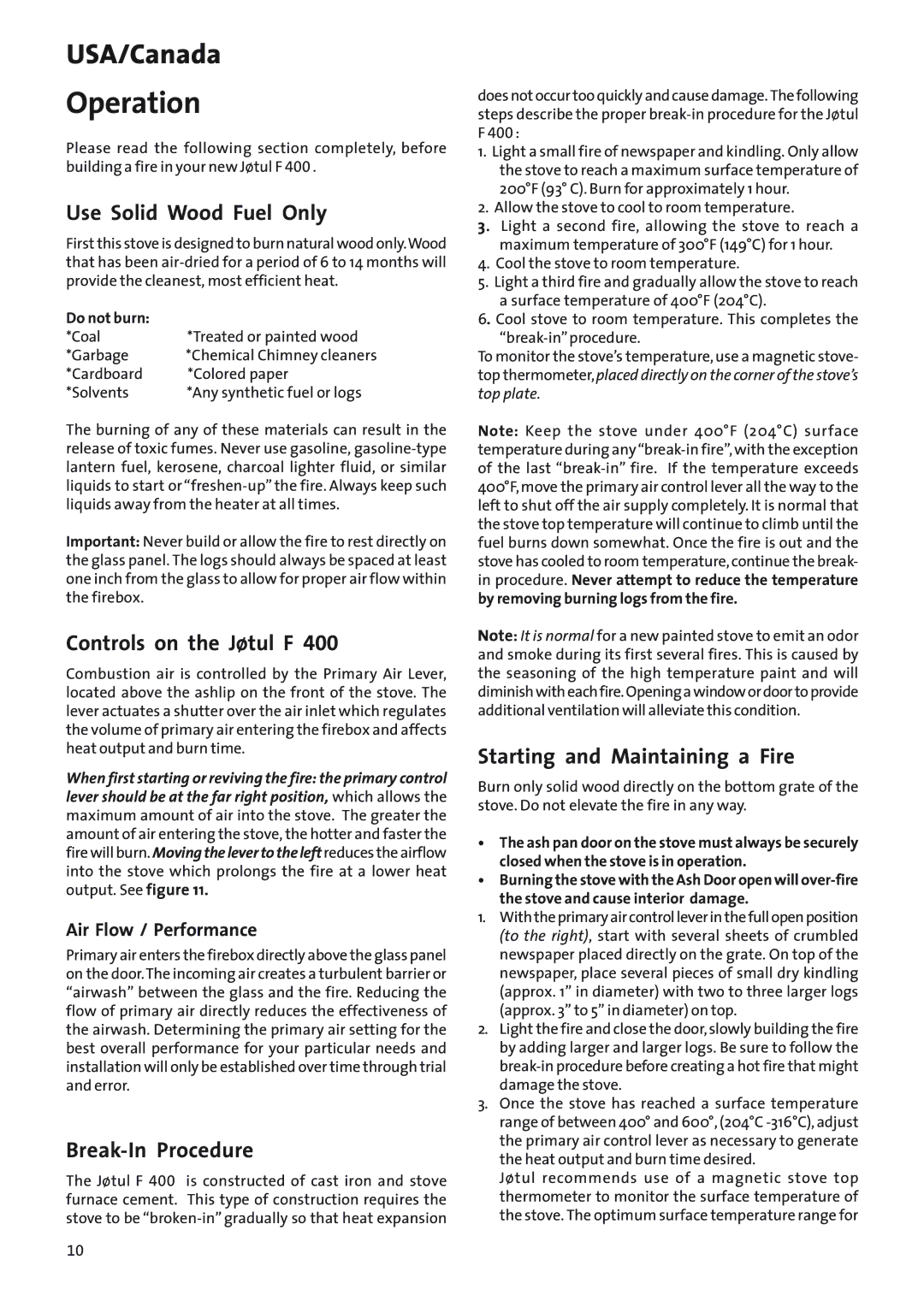USA/Canada
Operation
Please read the following section completely, before building a fire in your new Jøtul F 400 .
Use Solid Wood Fuel Only
First this stove is designed to burn natural wood only.Wood that has been air-dried for a period of 6 to 14 months will provide the cleanest, most efficient heat.
Do not burn: | *Treated or painted wood |
*Coal |
*Garbage | *Chemical Chimney cleaners |
*Cardboard | *Colored paper |
*Solvents | *Any synthetic fuel or logs |
The burning of any of these materials can result in the release of toxic fumes. Never use gasoline, gasoline-type lantern fuel, kerosene, charcoal lighter fluid, or similar liquids to start or “freshen-up” the fire. Always keep such liquids away from the heater at all times.
Important: Never build or allow the fire to rest directly on the glass panel. The logs should always be spaced at least one inch from the glass to allow for proper air flow within the firebox.
Controls on the Jøtul F 400
Combustion air is controlled by the Primary Air Lever, located above the ashlip on the front of the stove. The lever actuates a shutter over the air inlet which regulates the volume of primary air entering the firebox and affects heat output and burn time.
When first starting or reviving the fire: the primary control lever should be at the far right position, which allows the maximum amount of air into the stove. The greater the amount of air entering the stove, the hotter and faster the fire will burn. Moving the lever to the left reduces the airflow into the stove which prolongs the fire at a lower heat output. See figure 11.
Air Flow / Performance
Primary air enters the firebox directly above the glass panel on the door. The incoming air creates a turbulent barrier or “airwash” between the glass and the fire. Reducing the flow of primary air directly reduces the effectiveness of the airwash. Determining the primary air setting for the best overall performance for your particular needs and installation will only be established over time through trial and error.
Break-In Procedure
The Jøtul F 400 is constructed of cast iron and stove furnace cement. This type of construction requires the stove to be “broken-in” gradually so that heat expansion
does not occur too quickly and cause damage. The following steps describe the proper break-in procedure for the Jøtul F 400 :
1.Light a small fire of newspaper and kindling. Only allow the stove to reach a maximum surface temperature of 200°F (93° C). Burn for approximately 1 hour.
2.Allow the stove to cool to room temperature.
3. Light a second fire, allowing the stove to reach a maximum temperature of 300°F (149°C) for 1 hour.
4.Cool the stove to room temperature.
5.Light a third fire and gradually allow the stove to reach a surface temperature of 400°F (204°C).
6. Cool stove to room temperature. This completes the “break-in” procedure.
To monitor the stove’s temperature, use a magnetic stove- top thermometer, placed directly on the corner of the stove’s top plate.
Note: Keep the stove under 400°F (204°C) surface temperature during any “break-in fire”, with the exception of the last “break-in” fire. If the temperature exceeds 400°F, move the primary air control lever all the way to the left to shut off the air supply completely. It is normal that the stove top temperature will continue to climb until the fuel burns down somewhat. Once the fire is out and the stove has cooled to room temperature, continue the break- in procedure. Never attempt to reduce the temperature by removing burning logs from the fire.
Note: It is normal for a new painted stove to emit an odor and smoke during its first several fires. This is caused by the seasoning of the high temperature paint and will diminish with each fire. Opening a window or door to provide additional ventilation will alleviate this condition.
Starting and Maintaining a Fire
Burn only solid wood directly on the bottom grate of the stove. Do not elevate the fire in any way.
•The ash pan door on the stove must always be securely closed when the stove is in operation.
•Burning the stove with the Ash Door open will over-fire the stove and cause interior damage.
1.With the primary air control lever in the full open position (to the right), start with several sheets of crumbled newspaper placed directly on the grate. On top of the newspaper, place several pieces of small dry kindling (approx. 1” in diameter) with two to three larger logs (approx. 3” to 5” in diameter) on top.
2.Light the fire and close the door, slowly building the fire by adding larger and larger logs. Be sure to follow the break-in procedure before creating a hot fire that might damage the stove.
3.Once the stove has reached a surface temperature range of between 400° and 600°, (204°C -316°C), adjust the primary air control lever as necessary to generate the heat output and burn time desired.
Jøtul recommends use of a magnetic stove top thermometer to monitor the surface temperature of the stove. The optimum surface temperature range for
